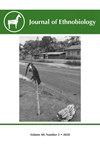西双版纳圣林与自然保护区树木多样性与更新
IF 1.3
3区 社会学
Q1 ANTHROPOLOGY
引用次数: 0
摘要
摘要圣山是少数民族傣族保护的神圣森林,在西双版纳引起了人们对保护的极大兴趣。西双版纳是世界上最北端的热带雨林之一,也是中国生物多样性最丰富的地区,尽管其中大部分地区受到橡胶种植造成的森林砍伐的威胁。作为自然保护区外仅存的一些森林碎片,Holy Hills被记录为包含稀有物种和生态系统,在保护区中代表性不足。尽管之前的研究提供了一些关于碎片化影响的见解,但它们缺乏研究人口结构的数据。因此,本研究首次使用了神圣树林中树木再生的连续指标,同时也借鉴了对人类干扰的社会生态背景的人种学理解,来研究三座圣山和两个自然保护区的生物多样性和再生。与较小的面积和碎片效应会降低圣山生物多样性的预期相反,我们发现圣山和自然保护区之间的多样性没有显著差异,尽管我们发现幼苗的多样性略有显著减少,某些圣山表现出向光需求物种的转变。常见和优势物种因地点而异,说明了在圣山之间捕获的斑块间β多样性的重要性,这可以支持区域物种库的维护。我们的研究结果也表明,圣山有相当大的再生机会,尽管个别遗址的条件和历史有很大的影响。我们建议与社区和地方机构合作,不仅要保护现有森林,还要再生和恢复具有文化意义的保护碎片。本文章由计算机程序翻译,如有差异,请以英文原文为准。
Tree Diversity and Regeneration in Sacred Groves and Nature Reserves in Xishuangbanna, Southwest China
Abstract. Holy Hills, sacred groves protected by ethnic minority Dai people, have garnered great interest for conservation in Xishuangbanna—a region containing some of the world's northernmost tropical rain forests and China's richest biodiversity, though much of it has been threatened by deforestation from rubber cultivation. As some of the only remaining forest fragments outside nature reserves, Holy Hills have been documented to contain rare species and ecosystems underrepresented in protected areas. Although previous studies provided some insight into fragmentation impacts, they lacked data to examine population structures. Accordingly, this study uses continuous metrics of tree regeneration for the first time in sacred groves, while also drawing on ethnographic understandings of socioecological contexts of human disturbance, to examine biodiversity and regeneration in three Holy Hills and two nature reserves. Contrary to expectations that smaller area and fragmentation effects would decrease biodiversity in Holy Hills, we found no significant difference in diversity between Holy Hills and nature reserves, though we detected marginally significantly less diversity in seedlings, and certain Holy Hills displayed a shift towards light-demanding species. Common and dominant species varied by site, speaking to the importance of inter-patch beta diversity captured among Holy Hills that can support the maintenance of a regional species pool. Our results also indicated considerable regeneration opportunity in Holy Hills, though individual site conditions and histories had a strong influence. We recommend collaborating with communities and local institutions not only to safeguard existing forest, but also to regenerate and restore fragments whose protection is bolstered with cultural meaning.
求助全文
通过发布文献求助,成功后即可免费获取论文全文。
去求助
来源期刊

Journal of Ethnobiology
Social Sciences-Anthropology
CiteScore
4.80
自引率
3.40%
发文量
21
审稿时长
>12 weeks
期刊介绍:
JoE’s readership is as wide and diverse as ethnobiology itself, with readers spanning from both the natural and social sciences. Not surprisingly, a glance at the papers published in the Journal reveals the depth and breadth of topics, extending from studies in archaeology and the origins of agriculture, to folk classification systems, to food composition, plants, birds, mammals, fungi and everything in between.
Research areas published in JoE include but are not limited to neo- and paleo-ethnobiology, zooarchaeology, ethnobotany, ethnozoology, ethnopharmacology, ethnoecology, linguistic ethnobiology, human paleoecology, and many other related fields of study within anthropology and biology, such as taxonomy, conservation biology, ethnography, political ecology, and cognitive and cultural anthropology.
JoE does not limit itself to a single perspective, approach or discipline, but seeks to represent the full spectrum and wide diversity of the field of ethnobiology, including cognitive, symbolic, linguistic, ecological, and economic aspects of human interactions with our living world. Articles that significantly advance ethnobiological theory and/or methodology are particularly welcome, as well as studies bridging across disciplines and knowledge systems. JoE does not publish uncontextualized data such as species lists; appropriate submissions must elaborate on the ethnobiological context of findings.
 求助内容:
求助内容: 应助结果提醒方式:
应助结果提醒方式:


